Today I’d like to introduce you to one of my personal herbal allies. I first met St. John’s wort in 1997, when I fired my psychiatrist.
I was diagnosed with severe post partum depression in 1989, after 3 pregnancy losses. 8 years later, I had already had 3 rounds of electric shock therapy, but it only made me feel worse. My young daughter was just 3 years old, and my body had started breaking down from the chemical storm the doctors wanted me to take for my “disorder”. At just 92 pounds there was nothing the doctors had to offer me, but more shock therapy. My body had quit digesting food. My gut was so inflamed from the prescription drugs, they thought I had celiacs. The drugs never worked. That was my “rock bottom”.
But then I met St. Johns Wort. St. Johns Wort was my Knight in Shining Armor, My Batman. I’ve never been back to the psychiatrist office. I quit all the chemicals the doctors had me on with the support of a new doctor.
I learned about St. Johns Wort from a book I found in a book store, by accident. It talked about clinical trials they were doing using the herb to treat depression. I ordered some seeds and started growing my own. In those days I didn’t even know if I could legally grow my own medicine. So I didn’t tell anyone. Now more than 20 years later, I’ve never had another depression. I’ve learned that St. Johns wort is so much more than an anti-depressant herb.
Yesterday was our annual St. Johns wort harvest. We have a “secret” patch of St. Johns wort that we harvest from every year. This year it was prime and in just 2 hours we were able to harvest enough St. Johns wort flowers to provide a year’s worth of both tincture and infused oil — 7 quarts for our family.
You might think of St. Johns wort as the herb for S.A.D. (seasonal affective disorder) or mild to medium depression. Scientists believe it acts like an M.A.O inhibitor to elevate the levels of the neurotransmitters norepinephrine, serotonin, and dopamine in the brain by inhibiting an enzyme called monoamine oxidase, that carries these neurotransmitters away once they are used up. By stopping this action there are more neurotransmitters to fire in the brain. With an increase in neurotransmitters the brain is able to work more efficiently and mood elevates. St. Johns wort acts without any food interactions or side effects, unlike the prescription MAO inhibitors. A few members of my family take St. Johns wort tincture at bedtime to get through the dark days of winter.
But St. Johns wort is so much more than the anti-depressant herb. It is a nervine that relieves pain by correcting faulty nerve pathways, and reducing inflammation. Any time there is sudden pain, shooting pain, or stabbing pain that indicates that nerves are involve, is a good time to reach for St. Johns wort. I’ve personally found it more reliable than OTC NSAID and Tylenol No. 3s for relief of lower back pain, neck pain, or joint pain.
We’ve also used it with broken bones, where there is sharp pain. Both as a tincture and as an infused oil to rub (gently) where the pain is. Hospitals don’t set many broken bones now. So using St. Johns wort oil is not impossible where there is no cast to interfere. Robin found it very helpful when he broke his ribs, falling on the ice.
St. Johns wort infused oil is also excellent as a carrier oil for salves along with calendula, plantain, comfrey, or any of the other skin supporting herbs. I use it in my herbal first aid salve. The one my Daughter in Law calls, “The magic sauce”.
St. John’s Wort is sedating and can be useful for insomnia, especially where you wake up in the middle of the night and can’t get back to sleep. For that reason its better to take it in the evening rather than the morning.
St. Johns wort is antibiotic for gram positive bacteria and is traditionally used for wound care where there is risk of infection. Soldiers have used St. Johns wort on the battle field since Alexander the Great, and possibly even earlier than that. This herb is also antiviral, antispasmodic, pain relieving. It is useful for painful periods and also for shingles virus.
Concerns with St. Johns Wort
Some “authorities” report that St. Johns wort is poisonous to livestock and can cause sun toxicity. We haven’t found that to be the case with sheep, llamas, and goats. None of our animals have had any problems with St. Johns Wort in the pasture with their normal grazing. Use caution though, if the pastures are poor and there are no other grazing plants. Also we haven’t had any issues with sun toxicity, when using St. Johns Wort tincture or oils. But we’re in Canada — so do use caution until you see how you personally react to it.
St. Johns wort is considered a noxious weed in some regions, so check with your local authority before you plant it.
There is some concern with drug interactions with St. Johns wort taken internally. Always check with your personal health professional if you are on prescription or OTC drugs and you plan to use St. Johns Wort, as it’s one of the more active herbal remedies.
Identifying St. Johns Wort:
St. Johns wort grows in waste places, roadsides, and meadows in temperate climate. It is a perennial and will come back in the same spot year after year, expanding by underground runners and seeds.
The plant grows 12 to 18 inches tall, with yellow flowers that have 5 petals. The botanical name Hypericum perforatum reminds us that the leaves and flowers have small holes or perforations that hold red/purple active compounds. As you harvest St. Johns wort flowers your fingers will take on this inky color. (It washes off easily with soap and water).
You can see the dots on the leaves and petals in the photo below.
Only the flowers and flower buds are used to make a tincture or infused oil. The flowers should be used fresh, if possible, for the most potent herbal remedy. Wilt them for 4 hours, then put them in a mason jar and pour 40% alcohol over them for a tincture or a carrier oil like extra virgin olive oil or Sweet almond oil.
Allow this to macerate in the jar in a sunny window for 30 to 45 days. Shake as often as you think of it. (This is one time when the admonition to place in a cool, dry place, should be ignored. More medicinal benefit is extracted when St. Johns wort is infused in sunlight).
Strain and rebottle in sanitized bottles. Label and date. Store in cool, dark place. To use: The tincture dose: 1/2 to 1 teaspoon up to 3 times a day for pain relief. 1 teaspoon at bedtime for relief of S.A.D. Note if it makes you drowsy and adjust accordingly.
The infused oil can be used liberally in external applications like massage oil, salve, or lotion bars.
DIY Herbal Tip:
Consider using St. Johns wort infused oil as a carrier oil for essential oils rollers that are meant for pain relief or first aid.
Your turn:
In the comments below tell us what your experience is with St. Johns wort. When do you reach for it most often? Which herbal remedies do you make with it?
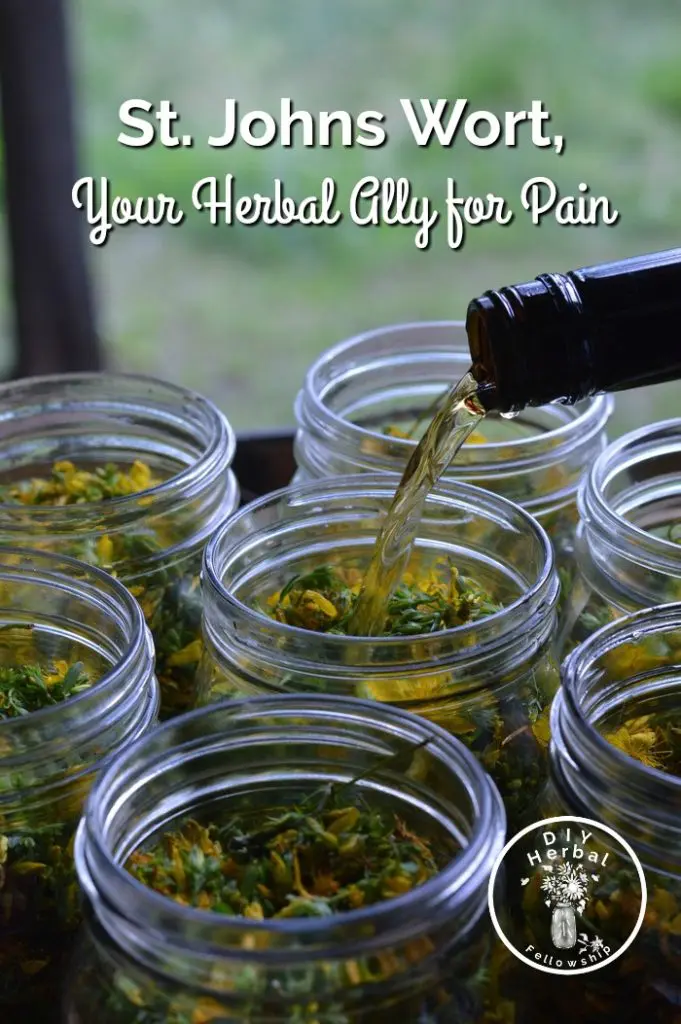
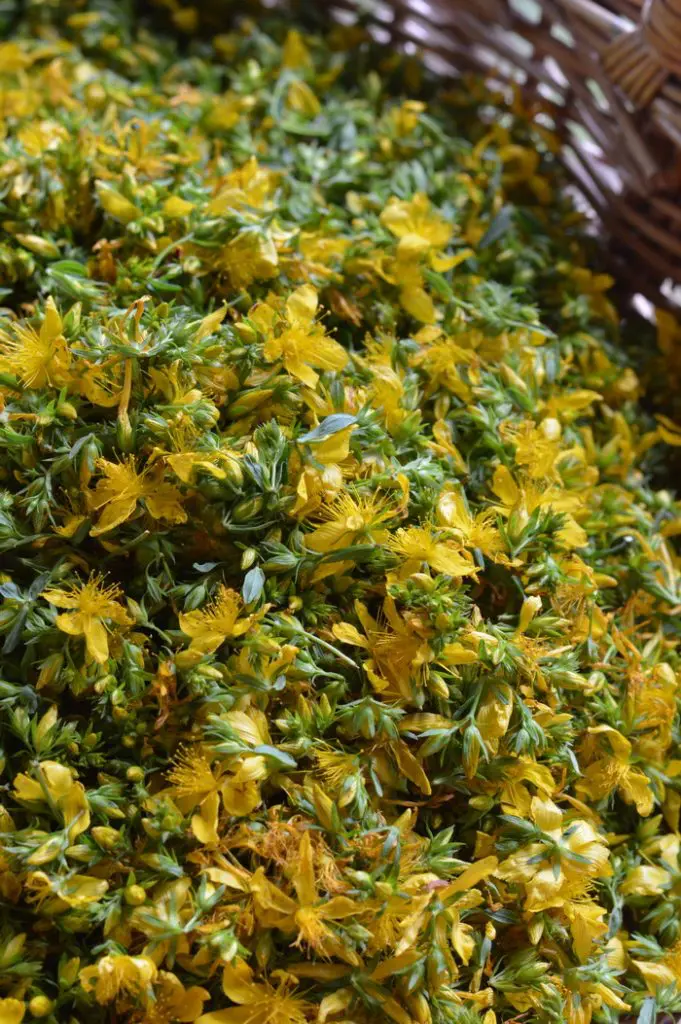
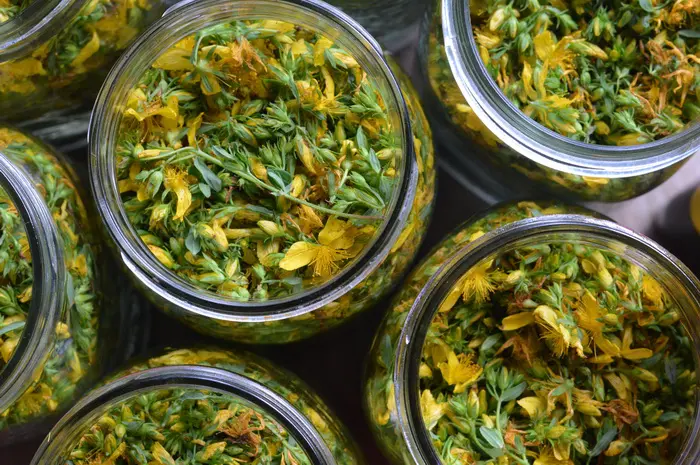
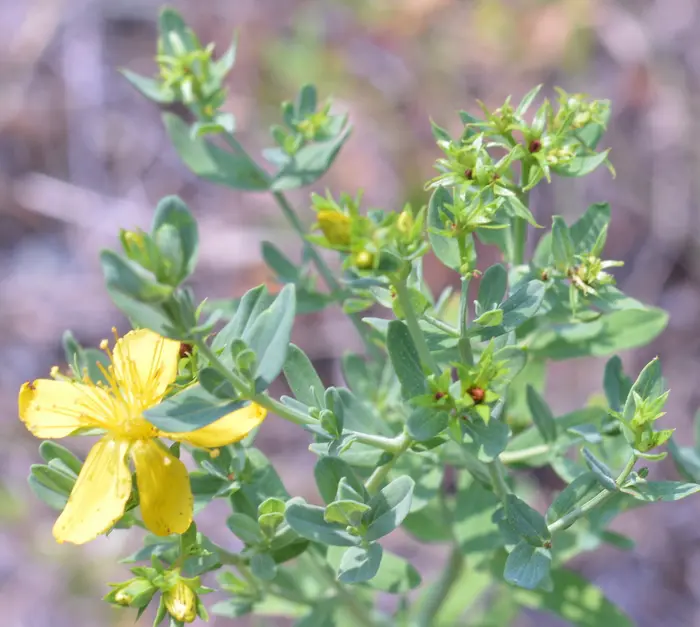
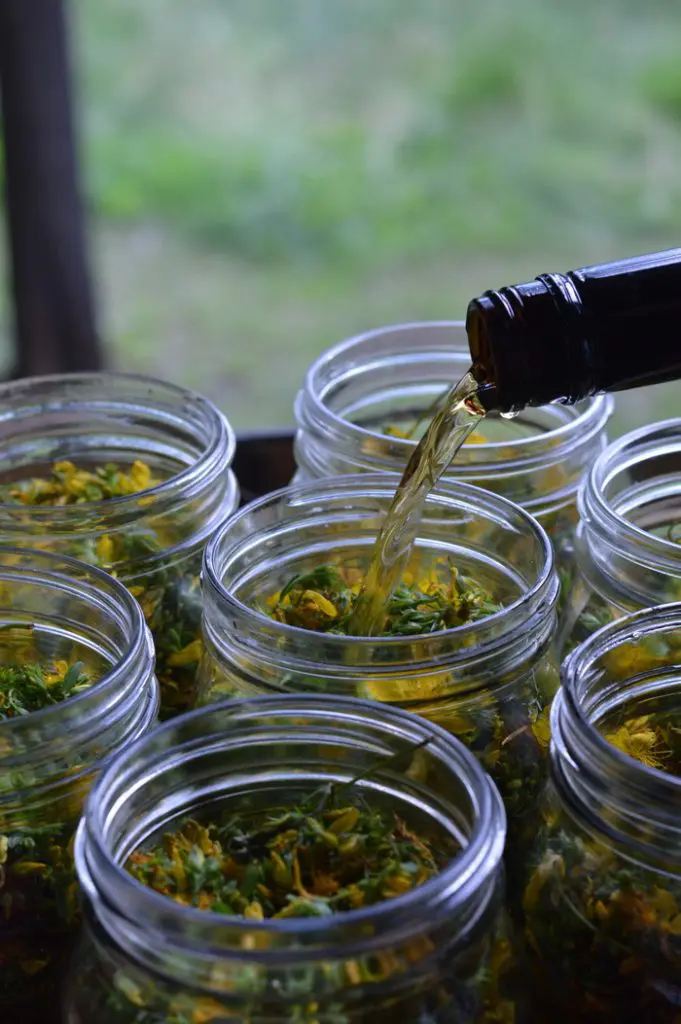

I’ve only recently planted a St. John’s Wort plant. I received one in the mail. It is not yet a foot tall. I didn’t see any blossoms on it this year.
I did purchase a bottle of St. John’s Wort from an herb store in the 1980’s and I’ve taken St. John’s Wort by capsule. It seemed to help me get rest and help with some of my low back pain. I’ve not taken it for several years.